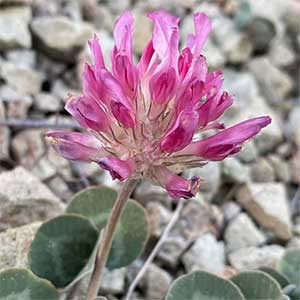Trifolium owyheense
Trifolium depauperatum
Owyhee clover
balloon sack clover, cowbag clover, dwarf sack clover, poverty clover
cespitose, spreading, branched proximally, sparsely branched distally.
erect or decumbent, branched.
palmate;
stipules broadly obovate, 1–2 cm, fused at base, margins slightly lobed, apex acute;
petiole 2–6 cm;
petiolules 1–1.5 mm;
leaflets 3, blades ovate, obovate, or orbiculate, slightly overlapping, 1–2 × 0.7–2.3 cm, base truncate to rounded, veins prominent, margins sparsely dentate, apex rounded, emarginate, surfaces glabrous.
palmate;
stipules sheathing proximally, ovate-oblong to lanceolate, 0.4–1.3 cm, margins entire or serrulate, apex short triangular-cuspidate;
petiole 1–5 cm;
petiolules to 1 mm;
leaflets 3, blades lanceolate, linear, obovate, or oblanceolate, 0.4–2.5 × 0.1–0.7 cm, base cuneate, veins moderately thickened abaxially, margins entire, serrate, or pinnately lobed, apex rounded, truncate, acute, or retuse, surfaces glabrous.
terminal, 20–30-flowered, globose, usually formed of 2 sessile heads, 2.5–5 × 2.5–5 cm;
involucres absent.
axillary or terminal, 3–15-flowered, globose or depressed-globose, 0.5–1.5 × 0.5–1.5 cm;
involucres flattened, 3–13 mm, ± distinct or incised 1/2 their length, lobes 5–7, linear to elliptic or irregular, or vestigial, reduced to narrow ring, apex rounded to broad and irregularly erose, not split.
3–7 cm, surpassing subtending leaves.
2–6 cm.
erect, reflexed in proximalmost flowers, 1 mm;
bracteoles cuplike, 0.5 mm.
straight, 0–0.5 mm;
bracteoles absent.
15–21 mm;
calyx tubular-campanulate, 9–12 mm, pilose, veins 10, tube 4.5–6 mm, lobes subequal, abaxialmost longest, subulate, orifice open;
corolla deep pink or magenta, 20–23 mm, banner tubular for most their length, 18–22 × 5–7 mm, apex flared.
3–10 mm;
calyx campanulate, 2–5 mm, glabrous, veins 5, tube 1–2.5 mm, lobes unequal, triangular-lanceolate or subulate, orifice open;
corolla white or pink, 3–11 mm, inflated in fruit, banner broadly ovate, 4–7 × 3–8 mm, apex rounded, broad, acute, or retuse.
ellipsoid, 4–5 mm.
sessile or stipitate, ovoid, obovoid, or oblong, 2–4 mm.
1 or 2, yellow-mottled, mitten-shaped, 2–3 mm, smooth.
1–6, gray or tan, mottled, mitten-shaped, 1.2–1.6 mm, irregularly bumpy.
= 16.
Trifolium owyheense
Trifolium depauperatum
Trifolium owyheense is known from about 40 populations in a small portion of east-central Malheur County in Oregon, and immediately adjacent Owyhee County in Idaho (M. Mancuso 2001).
(Discussion copyrighted by Flora of North America; reprinted with permission.)
Varieties 3 (3 in the flora).
The three varieties of Trifolium depauperatum are relatively easily distinguished by characteristics of the involucres and fruit stipes. Leaf morphology is not helpful in making the distinctions; in each variety, leaf margins can range from nearly entire or toothed or laciniate. In the phylogenetic treatment by N. W. Ellison et al. (2006), T. depauperatum is not allied with T. fucatum and other clovers with inflated corollas but rather with T. obtusiflorum, T. trichocalyx, and T. willdenovii (although with weak support).
(Discussion copyrighted by Flora of North America; reprinted with permission.)
1. Involucres reduced to narrow vestigial ring; inflorescences 1–1.5 cm diam.; flowers 7–10 mm; legumes ovoid, 3–4 mm, sessile. | var. depauperatum |
1. Involucres with evident bracts; inflorescences 0.5–1 cm diam.; flowers 3–8 mm; legumes oblong, ovoid, or obovoid, 2–4 mm, sessile or stipes 0.5–1 mm. | → 2 |
2. Involucral lobes broad, irregular, with broad, hyaline margins and reticulate veins; legumes oblong, 3–4 mm, ± sessile. | var. amplectens |
2. Involucral lobes oblong, often with narrow hyaline margins and raised, parallel veins; legumes ovoid or obovoid, 2–3 mm, stipes 0.5–1 mm. | var. truncatum |
- Local floras:
BC,
CA,
OR,
WA
- Local Web sites:
CalFlora,
CalPhotos,
Flora NW,
PNW Herbaria,
Turner Photog.
WildflowerSearch
iNaturalist (observations)
USDA Plants Database
- LBJ Wildflower Center
- SEINet
- Plants of the World Online
- Encyclopedia of Life
- Wikipedia
- Google Image Search


